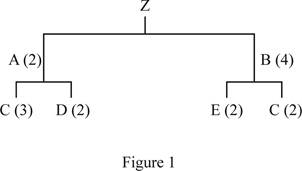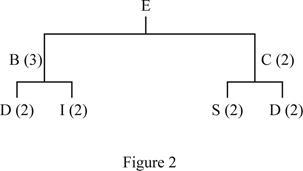
Concept explainers
a. One hundred twenty units of end item Z are needed at the beginning of week 7. Prepare a material requirements plan for component C. Take into account that on hand there are 40 units of Z, 70 units of A, 100 units of B, and 30 units of C. Also, there is a

b. Ninety-five units of end item E are needed at the beginning of week 7. Prepare a material requirements plan for component D. Take into account that 5 units of E are currently on hand, as well as 50 units of B, 100 units of C, and 80 units of D. Also, 30 units of C have been outsourced and are expected to arrive in week 4. Lead times are two weeks for E and C. and one week for the other components. Assume lot-for-lot ordering except for D. where multiples of 40 must be used.

a)
To prepare: A material requirements plan for Component C.
Introduction: Materials Requirement Planning (MRP) is the planning or scheduling system, which can be used in the manufacturing process. It is used to plan the number of items required to produce one unit of finished goods (end item)
Explanation of Solution
Given information:
120 units of end item (Z) are required at the beginning of Week 7. It is given that 40 units of Component Z, 100 units of Component B, 70 units of Component A, and 30 units of Component C are available on hand. Scheduled receipt is 20 units of Component C in Week 4. Lead-time is given as 2 weeks for Component Z and Component B and 1 week for other components. Lot size is lot-for-lot.
In addition to the above information, the following diagram is given:

Prepare a Material Requirement Plan (MRP) for Component Z:

- Gross requirement is given as 120 units at the beginning of Week 7.
- On-hand inventory is 40 units. It remains same until Week 6, as there is no demand.
- Net requirement can be calculated by subtracting the projected on hand inventory of previous week from the gross requirement of current week.
- 80 units are required at the beginning of Week 7. Hence, they need to order for 80 units (as the lot size is lot-for-lot) before two weeks (as the lead-time is 2 weeks), which means on Week 5.
- Projected on-hand inventory is calculated by adding the scheduled receipts and the value attained by subtracting gross requirements from the sum of projected on-hand of previous week and planned order receipt of previous week.
Prepare a Material Requirement Plan (MRP) for Component A (2):

- Component Z is the parent item of Component A (2). As the number of Component A is 2, the planned order release should be multiplied with 2 to determine the gross requirement of Component A.
- On-hand inventory is 70 units. It remains same until Week 4, as there is no demand.
- Net requirement can be calculated by subtracting the projected on hand inventory of previous week from the gross requirement of current week.
- 90 units are required at the beginning of Week 5. Hence, they need to order for 90 units (as the lot size is lot-for-lot) on previous week (as the lead-time is 1 weeks), which means on Week 4.
- Projected on-hand inventory is calculated by adding the scheduled receipts and the value attained by subtracting gross requirements from the sum of projected on-hand of previous week and planned order receipt of previous week.
Prepare a Material Requirement Plan (MRP) for Component B (4):

- Component Z is the parent item of Component B (4). As the number of Component B is 4, the planned order release should be multiplied with 4 to determine the gross requirement of Component B.
- On-hand inventory is 100 units. It remains same until Week 4, as there is no demand.
- Net requirement can be calculated by subtracting the projected on hand inventory of previous week from the gross requirement of current week.
- 220 units are required at the beginning of Week 5. Hence, they need to order for 220 units (as the lot size is lot-for-lot) on two weeks before (as the lead-time is 2 weeks), which means on Week 3.
- Projected on-hand inventory is calculated by adding the scheduled receipts and the value attained by subtracting gross requirements from the sum of projected on-hand of previous week and planned order receipt of previous week.
Prepare a Material Requirement Plan (MRP) for Component C (3) and C (2):

- Component A (2) is the parent item of Component C (3) and Component B (4) is the parent item of Component C (2). As the number of Component C is 3, the planned order release of Component A should be multiplied with 3 to determine the gross requirement of Component C. The same should be followed for Component C (2) with its parent item B (4).
- On-hand inventory is 30 units. It remains same until Week 3, as there is no demand.
- Net requirement can be calculated by subtracting the projected on hand inventory of previous week from the gross requirement of current week.
- 410 units are required at the beginning of Week 3. Hence, they need to order for 410 units (as the lot size is lot-for-lot) on previous week (as the lead-time is 1 week), which means on Week 2.
- Projected on-hand inventory is calculated by adding the scheduled receipts and the value attained by subtracting gross requirements from the sum of projected on-hand of previous week and planned order receipt of previous week.
- Projected on-hand inventory is calculated by adding the scheduled receipts and the value attained by subtracting gross requirements from the sum of projected on-hand of previous week and planned order receipt of previous week.
b)
To prepare: A material requirements plan for Component D.
Introduction: Materials Requirement Planning (MRP) is the planning or scheduling system, which can be used in the manufacturing process. It is used to plan the number of items required to produce one unit of finished goods (end item)
Explanation of Solution
Given information:
95 units of end item (E) are required at the beginning of Week 7. It is given that 5 units of Component E, 50 units of Component B, 80 units of Component D, and 100 units of Component C are available on hand. Scheduled receipt is 30 units of Component C in Week 4. Lead-time is given as 2 weeks for Component E and Component C and 1 week for other components. Lot size is lot-for-lot for all the components except Component D. Lot size for Component C is multiples of 40.
In addition to the above information, the following diagram is given:

Prepare a Material Requirement Plan (MRP) for Component E:

- Gross requirement is given as 95 units at the beginning of Week 7.
- On-hand inventory is 5 units. It remains same until Week 6, as there is no demand.
- Net requirement can be calculated by subtracting the projected on hand inventory of previous week from the gross requirement of current week.
- 90 units are required at the beginning of Week 7. Hence, they need to order for 90 units (as the lot size is lot-for-lot) before two weeks (as the lead-time is 2 weeks), which means on Week 5.
- Projected on-hand inventory is calculated by adding the scheduled receipts and the value attained by subtracting gross requirements from the sum of projected on-hand of previous week and planned order receipt of previous week.
Prepare a Material Requirement Plan (MRP) for Component B (3):

- Component E is the parent item of Component B (3). As the number of Component B is 3, the planned order release should be multiplied with 3 to determine the gross requirement of Component 3.
- On-hand inventory is 50 units. It remains same until Week 4, as there is no demand.
- Net requirement can be calculated by subtracting the projected on hand inventory of previous week from the gross requirement of current week.
- 220 units are required at the beginning of Week 5. Hence, they need to order for 220 units (as the lot size is lot-for-lot) on previous week (as the lead-time is 1 weeks), which means on Week 4.
- Projected on-hand inventory is calculated by adding the scheduled receipts and the value attained by subtracting gross requirements from the sum of projected on-hand of previous week and planned order receipt of previous week.
Prepare a Material Requirement Plan (MRP) for Component C (2):

- Component E is the parent item of Component C (2). As the number of Component C is 2, the planned order release should be multiplied with 2 to determine the gross requirement of Component C.
- On-hand inventory is 100 units. It remains same until Week 3, as there is no demand. Scheduled receipts of 30 units arrived on Week 4. Hence, the on-hand inventory is 130 units on Week 4.
- Net requirement can be calculated by subtracting the projected on hand inventory of previous week from the gross requirement of current week.
- 50 units are required at the beginning of Week 5. Hence, they need to order for 50 units (as the lot size is lot-for-lot) on two weeks before (as the lead-time is 2 weeks), which means on Week 3.
- Projected on-hand inventory is calculated by adding the scheduled receipts and the value attained by subtracting gross requirements from the sum of projected on-hand of previous week and planned order receipt of previous week.
- Projected on-hand inventory is calculated by adding the scheduled receipts and the value attained by subtracting gross requirements from the sum of projected on-hand of previous week and planned order receipt of previous week.
Prepare a Material Requirement Plan (MRP) for Component D (2) and D (2):

- Component B (3) is the parent item of Component D (2) and Component C (2) is the parent item of Component D (2). As the number of Component D is 2, the planned order release of Component B should be multiplied with 2 to determine the gross requirement of Component D. The same should be followed for Component D (2) with its parent item C (2).
- On-hand inventory is 80 units. It remains same until Week 3, as there is no demand.
- Net requirement can be calculated by subtracting the projected on hand inventory of previous week from the gross requirement of current week.
- 20 units are required at the beginning of Week 3. Hence, they need to order for 40 units (as the lot size is multiples of 40) on previous week (as the lead-time is 1 week), which means on Week 2.
- Projected on-hand inventory is calculated by adding the scheduled receipts and the value attained by subtracting gross requirements from the sum of projected on-hand of previous week and planned order receipt of previous week.
- Projected on-hand inventory is calculated by adding the scheduled receipts and the value attained by subtracting gross requirements from the sum of projected on-hand of previous week and planned order receipt of previous week.
Want to see more full solutions like this?
Chapter 12 Solutions
EBK OPERATIONS MANAGEMENT
Additional Business Textbook Solutions
Horngren's Accounting (12th Edition)
Principles of Microeconomics (MindTap Course List)
Principles Of Taxation For Business And Investment Planning 2020 Edition
Essentials of MIS (13th Edition)
Marketing: An Introduction (13th Edition)
Gitman: Principl Manageri Finance_15 (15th Edition) (What's New in Finance)
- How can businesses integrate Petri Net modeling with Little's Law to enhance supply chain resilience, especially in unexpected disruptions such as supplier delays or demand fluctuations?arrow_forwardLearning Activity 5: Expansion in Global Markets Discussion Questions: Bubble (or “boba”) tea is a milky tea containing chewy tapioca balls. It is has gained huge popularity in markets across Asia and is now also in North America and Europe. In your view will the recent exponential growth continue, and will it be at the expense of other drinks such as traditional black or green tea or coffee? Can global markets continue to support its growth, and what age group is mainly targeted?arrow_forwardDyson, a high-tech home appliance maker, has cut ties with Malaysian supplier ATA IMS Bhd following an audit of the company's labour practices and allegations by a whistleblower. ATA is already under US investigation over forced labour allegations. Dyson has terminated its contracts and is in talks with its customer over the audit findings. ATA, which produces parts for Dyson's vacuum cleaners and air purifiers, tumbled 30% to its lowest since April 2020. The termination is a significant blow for Malaysia, a major electronics manufacturing hub, which has faced scrutiny this year over claims of abusive working and living conditions. Dyson terminated the relationship with six months' contractual notice, hoping it would give ATA the impetus to improve and enable an orderly withdrawal in the interests of the workers they employ. Former ATA worker Dhan Kumar Limbu was beaten by police in Malaysia after sharing information about conditions at the factory with activists. ATA denied all…arrow_forward
- Question content area Part 1 Oakwood Hospital is considering using ABC analysis to classify laboratory SKUs into three categories: those that will be delivered daily from their supplier (Class A items), those that will be controlled using a continuous review system (B items), and those that will be held in a two bin system (C items). The following table shows the annual dollar usage for a sample of eight SKUs. Fill in the blanks for annual dollar usage below. (Enter your responses rounded to the nearest whole number.) Part 2 Rank the SKUs in descending order on the basis of their annual dollar usage and fill in the table with the ranked SKU's percentage of dollar usage. (Enter your responses rounded to two decimal places.)arrow_forwardSam's Pet Hotel operates 51 weeks per year, 6 days per week, and uses a continuous review inventory system. It purchases kitty litter for $13.00 per bag. The following information is available about these bags: > Demand 70 bags/week > Order cost $58.00/order > Annual holding cost 30 percent of cost > Desired cycle-service level = 80 percent >Lead time 4 weeks (24 working days) > Standard deviation of weekly demand = 15 bags > Current on-hand inventory is 320 bags, with no open orders or backorders. a. Suppose that the weekly demand forecast of 70 bags is incorrect and actual demand averages only 45 bags per week. How much higher will total costs be, owing to the distorted EOQ caused by this forecast error? The costs will be $ higher owing to the error in EOQ. (Enter your response rounded to two decimal places.)arrow_forwarda. The average aggregate inventory value of the product if Ruby-Star used vendor 1 exclusively is $enter your response here. (Enter your response as a whole number.) b. The aggregate inventory value of the product if Ruby-Star used vendor 2 exclusively is shown below. c. How would your analysis change if average weekly demand increased to 160 units per week? The aggregate inventory values are shown below.arrow_forward
- a. What order quantity should be used? lures. (Enter your response rounded to the nearest whole number.) b. What reorder point should be used? (Enter your response rounded to the nearest whole number.) c. What is the total annual cost for this inventory system? (Enter your response rounded to two decimal places)arrow_forwardOakwood Hospital is considering using ABC analysis to classify laboratory SKUS into three categories: those that will be delivered daily from their supplier (Class A items), those that will be controlled using a continuous review system (B items), and those that will be held in a two bin system (C items). The following table shows the annual dollar usage for a sample of eight SKUS. Fill in the blanks for annual dollar usage below. (Enter your responses rounded to the nearest whole number.) SKU Unit Value Demand (units) Annual Dollar Usage 1 $1.10 30,000 $ 2 $0.02 125,000 $ 3 $0.20 65,000 S 4 $0.02 1,100 SA 5 $1.40 150 SA 678 $4.10 900 $ $0.80 350 $ $0.55 80 EA $arrow_forwardDyson, a high-tech home appliance maker, has cut ties with Malaysian supplier ATA IMS Bhd following an audit of the company's labour practices and allegations by a whistleblower. ATA is already under US investigation over forced labour allegations. Dyson has terminated its contracts and is in talks with its customer over the audit findings. ATA, which produces parts for Dyson's vacuum cleaners and air purifiers, tumbled 30% to its lowest since April 2020. The termination is a significant blow for Malaysia, a major electronics manufacturing hub, which has faced scrutiny this year over claims of abusive working and living conditions. Dyson terminated the relationship with six months' contractual notice, hoping it would give ATA the impetus to improve and enable an orderly withdrawal in the interests of the workers they employ. Former ATA worker Dhan Kumar Limbu was beaten by police in Malaysia after sharing information about conditions at the factory with activists. ATA denied all…arrow_forward
- Question 4 (25 Marks) Discuss how developing internal performance measures to track the performance of supplier development, can create efficiency for Pick n Pay.arrow_forwardLeadership and people Earlier this year, Pick n Pay actioned the first priority of the plan: the introduction of a new, simplified and seasoned leadership team with proven track records. The team has already implemented strengthened structures, including establishing regional trading areas with local decision-making, with clear sight of strong long-term succession Each operating region now has a regional buying team and store management team in place to meet specific customer needs particular to that region, while also increasing staff training and productivity for an overall improved store experience. Reset the store estate To create a more sustainable supermarket business, the Group is resetting its store estate to minimise losses by creating a smaller but more profitable Pick n Pay store estate. The plan is to leverage the strength of its multi-format model with strategic conversions to lift store profitability: selected Pick n Pay stores will be converted to Boxer, where customer…arrow_forwardQuestion 3 (25 Marks) Elaborate on how Pick n Pay could use information technology and ERP systems across the company and their suppliers to improve their operating model? Question 4 (25 Marks)arrow_forward
 Practical Management ScienceOperations ManagementISBN:9781337406659Author:WINSTON, Wayne L.Publisher:Cengage,MarketingMarketingISBN:9780357033791Author:Pride, William MPublisher:South Western Educational Publishing
Practical Management ScienceOperations ManagementISBN:9781337406659Author:WINSTON, Wayne L.Publisher:Cengage,MarketingMarketingISBN:9780357033791Author:Pride, William MPublisher:South Western Educational Publishing Purchasing and Supply Chain ManagementOperations ManagementISBN:9781285869681Author:Robert M. Monczka, Robert B. Handfield, Larry C. Giunipero, James L. PattersonPublisher:Cengage Learning
Purchasing and Supply Chain ManagementOperations ManagementISBN:9781285869681Author:Robert M. Monczka, Robert B. Handfield, Larry C. Giunipero, James L. PattersonPublisher:Cengage Learning Contemporary MarketingMarketingISBN:9780357033777Author:Louis E. Boone, David L. KurtzPublisher:Cengage Learning
Contemporary MarketingMarketingISBN:9780357033777Author:Louis E. Boone, David L. KurtzPublisher:Cengage Learning





